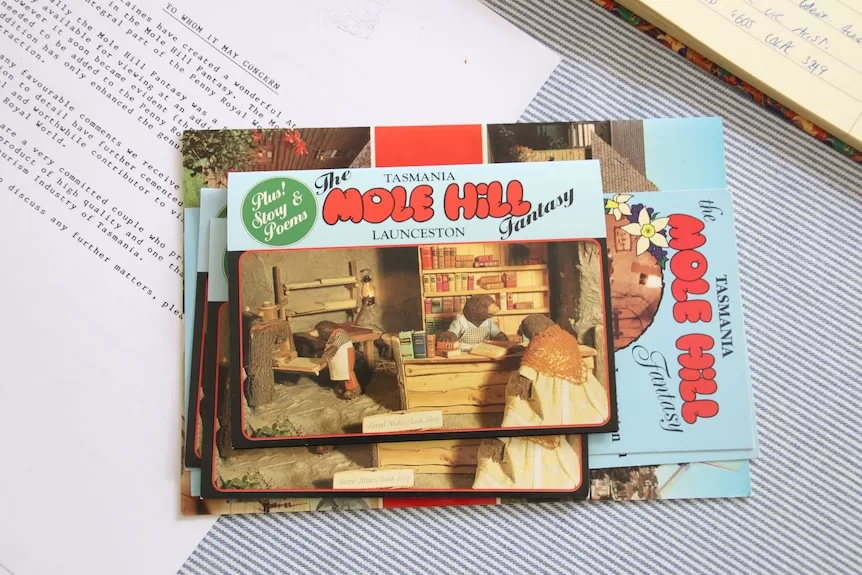- In short: Mole Hill Fantasy was a hugely popular attraction in northern Tasmania during the 1980s and 1990s, with many locals and tourists holding fond memories of the unique diorama.
- Due to rising costs, the popular exhibit was eventually sold interstate but never saw the light of day again. It now sits in a storage shed.
- What’s next? One of the original creators, Valerie Staines, wants to publish a book about the inhabitants of Mole Hill Fantasy written by her late husband Max.
These days it is well known for its spectacular underground cave network, but the small town of Mole Creek in northern Tasmania once hosted a very different type of cave attraction.
Mole Hill Fantasy, a miniature underground world for moles, was the brainchild of English migrants Max and Valerie Staines, who owned the Mole Creek Holiday Village in the 1980s.
ABC News: Georgia Hogge
)
Featuring 130 miniature moles made by hand, Mole Hill Fantasy depicted a world where moles did everyday things, in a subterranean version of pre-industrial England that was big on detail, but small on size.
“Max wanted to build it as a small attraction, because of the name Mole Creek and because we came from England where moles are more common,” Valerie Staines told ABC Northern Tasmania Breakfast.
“He thought, because the moles were only six inches high, you could create a little village in a small place.”
Max used plaster casts and expanding foam to build the tiny moles and foraged for local sticks and twigs to construct an elaborate fibreglass cave model. Valerie was responsible for clothing the moles and the finer details of the exhibit.
“Everything was done with minute attention to detail,” she said. “We actually made all the little bricks and the ceramics by hand and fired it in a kiln.”
ABC News: Georgia Hogge
)
Visitors had fond memories
When Max and Valerie Staines sold the Mole Creek Holiday Village, the unique exhibition stayed on site for a year in its own building while the couple were working out what to do with it.
The holiday park’s new owner, Kaye Mathews, said the extensive diorama was popular with all guests, whether they were staying overnight or not.
ABC News: Georgia Hogge
)
“We just had wonderful visits from people always happy to see the little moles doing their thing,” she said.
“Max was a real artist, he had come from England. He was a very talented man.”
Launceston woman Megan Corp was one of the guests who visited as a child.
She said she convinced her family to take her to the Mole Hill Fantasy exhibit as part of a road trip.
“I was really into little things when I was a kid — doll houses and things like that,” she said.
ABC News: Georgia Hogge
)
“I have really fond memories of seeing it with my mum and my nanna. We spent quite a long time in there, looking at all the intricate details.”
Valerie Staines says the key to the exhibit was the lighting, which was very nuanced.
“It was dark, so people walked in and you had to let your eyes adjust first,” she explained. “People walked around and the only thing lit up were the caves, it was mystical.”
A recent post on ABC Northern Tasmania’s Facebook page received hundreds of comments, with people keen to share their fond memories of the exhibit.
I used to love this place. — Fiona Lawson
As a child, I can still remember my fascination with this special little place. I can still recall being so mesmerised walking around taking it all in. Beautiful memories. — Alana Beveridge
This was an excellent Trevallyn Primary School excursion, around the mid-90s. — Krystelle Harvey
Moles now living in storage interstate
In late 1991, the diorama was moved to the Penny Royal tourist site in Launceston where it continued to fascinate visitors in an expanded form that showed the moles living during four different seasons.
But after Max’s passing in 1996 and with insurance costs rising and other on-site issues, Ms Staines was eventually forced to sell the exhibit.
“I had to sell it and I tried to find somewhere to place it in Tasmania, with great effort,” Ms Staines said.
“I had lots of kind help from a real estate agent, but we couldn’t find anywhere.
“Eventually, a guy in New South Wales wanted it. He came down and bought it.”
That guy was John Wakeling, the former owner of a paddle steamer on the Hawkesbury River, who planned to make it into an attraction.
But the moles were never put on display.
We tracked down where the exhibit now lives in a shed in Penrith.
The dioramas are in a greatly deteriorated state but the figures are in better condition.
Book of mole stories planned
While Valerie Staines remains disappointed that Mole Hill Fantasy never found a permanent home in Tasmania, she is keen to keep its memory alive among locals.
This year she is planning to publish a story that Max wrote about the moles of Mole Hill, but she needs to illustrate the book first.
The 84-year-old said it would be a good way to maintain the legacy of what she and her husband achieved, all those years ago.
“Max would just be overwhelmed if he were alive now … it’s just so lovely that people remember it so well.”
“It was just a little world of little moles living, it was very special.”
LoadingLoading…
